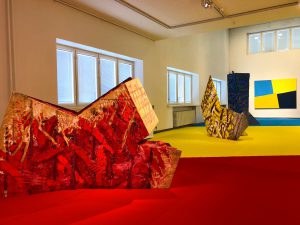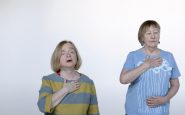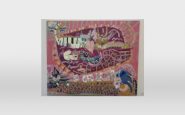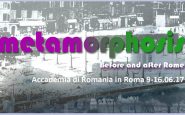« Indietro
Intervistiamo Pirjo Immonen, curatrice, giornalista, direttore del Taidemuseo di Kajaani, nel cuore della Finlandia.
What is the nature of Kajaani's Taidemuseum for those who don't know it? What kind of artists and activities do you normally perform?
The Kajaani Art Museum is a small, active and welcoming museum situated in the heart of Kajaani. Our strength is in working closely with our community and bringing many activities for our audience: workshops, performances, discussions, lectures, meetings with artists. We have free admission for all and the visitor is the most important person in our museum. The 85-year-old former police station – of beautiful functionalist style - now serves as a venue to see and experience art. We produce four exhibitions of internationally and locally interesting art in a year, mostly together with contemporary artists. We are open to new forms of art and try to listen carefully what is happening in the society and in the world.
We have a good selection of Finnish contemporary art in our collections. We started a new project this year where we exhibit an artwork of the month, chosen monthly from our collections by the citizens of Kajaani. This project continues on our website and on social media during the crisis.
The pandemic lockdown has also forced Finland to stop ongoing projects and close museums. What was on display at the time of closure?
We had just opened an exhibition for children and families which had only been open for three weeks before the closing of museums in Finland. It is a collaborative project with the Centre of Children’s and Youth’s Culture of our region. The exhibition Väreilyä focuses thematically on colour and emotions; the colour pieces are picked from the art museum’s own collections and they are surrounded with experiential colour adventure activities. The underlying thought is that colours have a strong impact on our emotions and on recognizing and experiencing them.
The curators, producer Emilia Hyvönen and artist educator Saara Karjalainen were free to choose the works from our collections and to plan and build the atmosphere of the spaces in the art museum together with our staff.
We also have two mascots designed for the exhibition: at the moment they are sleeping in a greenhouse waiting for the children to come and wake them up. And soon we will have a virtual tour to this exhibition on our website with the curator Saara Karjalainen.
The future of museums (and culture in general) has to be reconsidered, we will have to find a way to live with such a situation for at least another year. How are you organising the museum, have you developed strategies for the reopening?
I feel very humble in front of this situation, we don’t know a lot about the virus, how long the crisis will last or how it will develop – and we don’t know when we can open the doors of the museums. We also have huge economic challenges in front of us.
We have of course made some practical decisions for the future: our summer exhibition of Marjatta Tapiola’s paintings is postponed - in agreement with the artist – to the summer 2021. As soon as we can open the museum again, we will continue with the Väreilyä exhibition for children which most of our audience haven’t seen yet. During this and the coming years it is possible that we will face other changes, too.
The chosen values in our strategy have an important role now as we are making new plans on how to meet our audience, our community and our artists after the crisis and also during it. How to be close to our audience from a distance and how to strengthen and courage people with our professional means, the means of art.

You are also a curator, what is the current situation for the artists in Finland?
The situation is of course difficult. The closure of exhibition venues, postponed exhibitions, cancelled commissions – all effect the economic situation of the visual artists. Luckily The Ministry of Education and Culture together with a number of big foundations, like the Finnish Cultural Foundation, reacted very quickly to grant swift assistance to arts and culture professionals who have been hit hard by the coronavirus outbreak. The foundations will also grant significant sums of aid to artists through their own channels. This is a sign of collective responsibility.
The art and culture network has done great co-operation, and we can see art virtually and also in the windows of museums and galleries. The situation has changed our ways of showing and seeing art.
How the role of museums will change in the near future according to you?
The strength of the museums will surely be in their ability to reform. During the crisis we have already developed new ways to show art virtually and digitalization has taken huge steps. Anyway I believe that the biggest change will happen regarding our way to work with the audience. The museum will always stay as a place where people come to see art in reality, to experience something special, to learn, to meditate or to meet others. The value of art remains, it doesn’t give quick pleasure or entertainment but makes us understand the world and its changes and the most important things in life.
Is there an online initiative, by museums or artists, that you want to share with us?
A recently opened Finnish website where you can give professional and high quality tips for children and parents on what to do at home in the times of the quarantine: harrastakotona.fi.
It is a website designed for children and youth, giving tips and ideas on how to experience, learn and experiment with art at home, in your free time or as a part of learning at school.
Thank you Pirjo Immonen!
Foto:
Pirjo Immonen con il pubblico al Museo di Kajaani
Sculture dalla collezione del museo (Pauno Pohjolainen: Three sisters, 1982-83)
Il mondo dell’arte al tempo della pandemia/2. Intervista a Pirjo Immonen, direttore del Taidemuseo di Kajaani
Il 01/05/2020
Intervistiamo Pirjo Immonen, curatrice, giornalista, direttore del Taidemuseo di Kajaani, nel cuore della Finlandia.
What is the nature of Kajaani's Taidemuseum for those who don't know it? What kind of artists and activities do you normally perform?
The Kajaani Art Museum is a small, active and welcoming museum situated in the heart of Kajaani. Our strength is in working closely with our community and bringing many activities for our audience: workshops, performances, discussions, lectures, meetings with artists. We have free admission for all and the visitor is the most important person in our museum. The 85-year-old former police station – of beautiful functionalist style - now serves as a venue to see and experience art. We produce four exhibitions of internationally and locally interesting art in a year, mostly together with contemporary artists. We are open to new forms of art and try to listen carefully what is happening in the society and in the world.
We have a good selection of Finnish contemporary art in our collections. We started a new project this year where we exhibit an artwork of the month, chosen monthly from our collections by the citizens of Kajaani. This project continues on our website and on social media during the crisis.
The pandemic lockdown has also forced Finland to stop ongoing projects and close museums. What was on display at the time of closure?
We had just opened an exhibition for children and families which had only been open for three weeks before the closing of museums in Finland. It is a collaborative project with the Centre of Children’s and Youth’s Culture of our region. The exhibition Väreilyä focuses thematically on colour and emotions; the colour pieces are picked from the art museum’s own collections and they are surrounded with experiential colour adventure activities. The underlying thought is that colours have a strong impact on our emotions and on recognizing and experiencing them.
The curators, producer Emilia Hyvönen and artist educator Saara Karjalainen were free to choose the works from our collections and to plan and build the atmosphere of the spaces in the art museum together with our staff.
We also have two mascots designed for the exhibition: at the moment they are sleeping in a greenhouse waiting for the children to come and wake them up. And soon we will have a virtual tour to this exhibition on our website with the curator Saara Karjalainen.
The future of museums (and culture in general) has to be reconsidered, we will have to find a way to live with such a situation for at least another year. How are you organising the museum, have you developed strategies for the reopening?
I feel very humble in front of this situation, we don’t know a lot about the virus, how long the crisis will last or how it will develop – and we don’t know when we can open the doors of the museums. We also have huge economic challenges in front of us.
We have of course made some practical decisions for the future: our summer exhibition of Marjatta Tapiola’s paintings is postponed - in agreement with the artist – to the summer 2021. As soon as we can open the museum again, we will continue with the Väreilyä exhibition for children which most of our audience haven’t seen yet. During this and the coming years it is possible that we will face other changes, too.
The chosen values in our strategy have an important role now as we are making new plans on how to meet our audience, our community and our artists after the crisis and also during it. How to be close to our audience from a distance and how to strengthen and courage people with our professional means, the means of art.

You are also a curator, what is the current situation for the artists in Finland?
The situation is of course difficult. The closure of exhibition venues, postponed exhibitions, cancelled commissions – all effect the economic situation of the visual artists. Luckily The Ministry of Education and Culture together with a number of big foundations, like the Finnish Cultural Foundation, reacted very quickly to grant swift assistance to arts and culture professionals who have been hit hard by the coronavirus outbreak. The foundations will also grant significant sums of aid to artists through their own channels. This is a sign of collective responsibility.
The art and culture network has done great co-operation, and we can see art virtually and also in the windows of museums and galleries. The situation has changed our ways of showing and seeing art.
How the role of museums will change in the near future according to you?
The strength of the museums will surely be in their ability to reform. During the crisis we have already developed new ways to show art virtually and digitalization has taken huge steps. Anyway I believe that the biggest change will happen regarding our way to work with the audience. The museum will always stay as a place where people come to see art in reality, to experience something special, to learn, to meditate or to meet others. The value of art remains, it doesn’t give quick pleasure or entertainment but makes us understand the world and its changes and the most important things in life.
Is there an online initiative, by museums or artists, that you want to share with us?
A recently opened Finnish website where you can give professional and high quality tips for children and parents on what to do at home in the times of the quarantine: harrastakotona.fi.
It is a website designed for children and youth, giving tips and ideas on how to experience, learn and experiment with art at home, in your free time or as a part of learning at school.
Thank you Pirjo Immonen!
Foto:
Pirjo Immonen con il pubblico al Museo di Kajaani
Sculture dalla collezione del museo (Pauno Pohjolainen: Three sisters, 1982-83)




